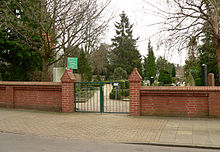Kirchröder cemetery
The Kirchröder Friedhof is a 19th century cemetery in Hanover , which is now a listed building . It is maintained by the Evangelical Lutheran parish of the Jakobikirche in Hanover-Kirchrode and called by them the cemetery of the Jakobikirchengemeinde in Hanover-Kirchrode , also known as the cemetery of the Jakobigemeinde . It is located at 5 Kleiner Hillen on the corner of Pastor-Gerhard-Dittrich-Weg .
history

When the former cemetery around the Jakobikirche, first documented in 1295, was no longer sufficient for further burials, the community established its new cemetery on Kleiner Hillen in 1864 . From the period that followed in the last quarter of the 19th century "some beautiful gravestones [...] have survived". In the western, today “old part” of the cemetery, there are still “graves of old Kirchroder families: Borchers, Wulf, Meyer, Bremer, Behre, Homann, Wiese, Wichmann and Kracke”. The oldest preserved tombs, however, are those of "the economist Heinrich Rathing (1795 to 1876) and his wife Charlotte (1817 to 1881)".
The so-called Bödekerengel at the head of the grave site of the Erich Flügel family (1906–1984) also dates from the 19th century . Up until 2013, local historians had assumed that of the listed, formerly 15 copies, only the two in the Stöcken city cemetery and the Engesohde city cemetery in Hanover had survived. The Bödekerenangels were designed by the sculptor Georg Hurtzig in 1854 and created in Lauterberg . They were used by the then pastor of the Marktkirche in Hanover to collect donations, for example with the help of the North German Morning Promenade Transport Association that he founded .
In 1951 the cemetery was expanded to its current (as of 07/2013) total area of around 0.87 hectares by the new part , which extends to the southeast. Tombs of important personalities have been preserved from this period, such as that of the first Hanover city director after the Second World War , Gustav Bratke, who died in 1952 . In the “New Part”, for example, there is also the grave stele by architect Ernst Zinsser .
See also
literature
- Wolfgang Neß : The old village. In: Monument topography of the Federal Republic of Germany , architectural monuments in Lower Saxony, city of Hanover, part 2, volume 10.2, ISBN 3-528-06208-8 , p. 92f., As well as Kirchrode in the appendix directory of architectural monuments acc. § 4 (NDSchG) (except for architectural monuments of the archaeological monument preservation) , status July 1, 1985, City of Hanover. Lower Saxony State Administration Office - Institute for Monument Preservation , p. 19
- Peter Schulze : Cemeteries. In: Klaus Mlynek, Waldemar R. Röhrbein (eds.) U. a .: City Lexicon Hanover . From the beginning to the present. Schlütersche, Hannover 2009, ISBN 978-3-89993-662-9 , pp. 193-196.
- Martin Anger, H. Dreimann u. a .: Chronicle. Kirchrode in words and pictures , Hanover, TT-Verlag, 1983
Web links
Individual evidence
- ↑ a b Wolfgang Neß: The old village (see literature)
- ↑ a b c d e Klaus Hagelberg, Rolf Wohlfahrt: The cemetery of the Jakobikirchengemeinde ... (see in the section on web links )
- ↑ a b c Peter Schulze: Friedhöfe (see in the literature section )
- ↑ a b c Compare the documentation at Commons (see under the section Weblinks )
- ^ Helmut Knocke , Hugo Thielen : Kleiner Hillen 2. In: Hannover Art and Culture Lexicon , p. 157
- ^ Hugo Thielen : Hurtzig, (2) Georg. In: Stadtlexikon Hannover , p. 312
- ^ Waldemar R. Röhrbein : North German morning promenade transport association. In: Stadtlexikon Hannover , p. 480
- ↑ Klaus Mlynek : BRATKE, Gustav. In: Dirk Böttcher , Klaus Mlynek, Waldemar R. Röhrbein, Hugo Thielen: Hannoversches Biographisches Lexikon . From the beginning to the present. Schlütersche, Hannover 2002, ISBN 3-87706-706-9 , pp. 69f .; online through google books
Coordinates: 52 ° 21 ′ 28.8 ″ N , 9 ° 49 ′ 30 ″ E

